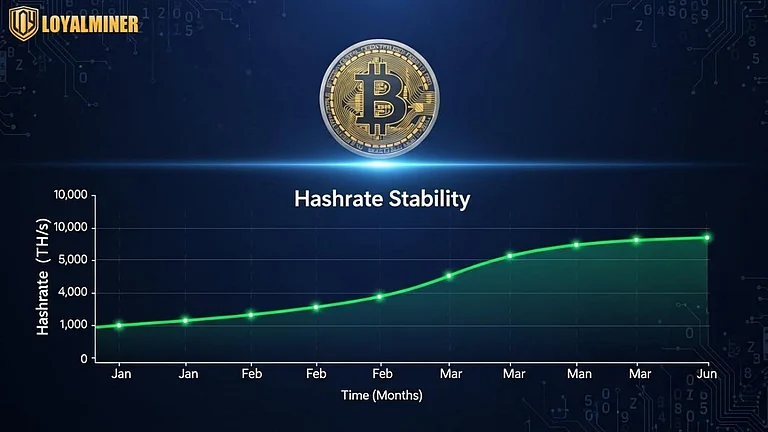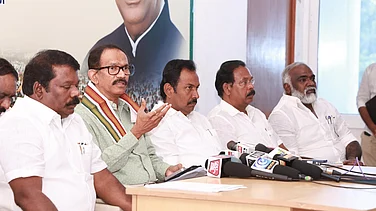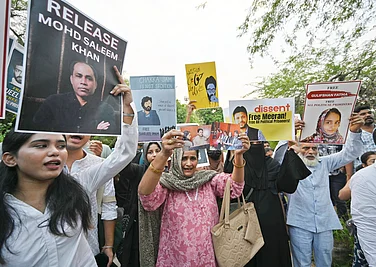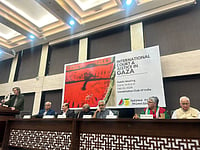Munna Qureshi feels dizzy in close, cramped spaces. The heat and fumes emanating from gas cutters reflect off the walls of the narrow, cramped tunnel. Tiny, dark spaces, like the one he often finds himself in, make him giddy. Even the shards of light from the flames spitting out of the gas cutters do not help. The flames run the risk of injury and the fumes make him gasp for air.
The risks that Munna, 33, and other rat-hole miners like him run when they descend—sometimes fifteen metres into the earth—using only a narrow three-four foot pipe as a flimsy portal into the subterranean are immense. It is a portal that for many rat-hole miners has also doubled up as a cramped coffin in the past.
Last month, when all efforts that money and might muster, including the commissioning of an expensive Auger drill machine, failed, hopes were pinned on rat-hole miners like Munna to burrow out the last of the debris from the Silkyara-Barkot tunnel. The tunnel had collapsed on November 12, trapping 41 workers inside for 17 days. It took 12 rat-hole miners from Dalit and Muslim communities in Delhi and Uttar Pradesh to extract them, when all the wherewithal of the state had failed.
Clearing debris and sewage fifteen metres below the surface is dark, dangerous living. After spending most of their days cramped in the narrow, dark cavity, when the first ray of the sun hits their bodies after they surface, it feels as if a “heavy load has been taken off our backs,” says Munna, who was involved in the Silkyara-Barkot tunnel rescue operation. The surface, he says, is a safe place to live.
When Munna and Waqeel Hassan, 45, descended through the 80-cm diameter pipe pushed inside the debris at the Uttarakhand crash site, the anxiety of the ‘do or die’ task confronting them overpowered all other personal fears they faced. Between them and the 41 trapped men, between them and the hopes of a nation and between them and the kin of the trapped tunnellers lay 10 metres of debris. One thought inspired the heroism of the 12 rat-hole miners. “We have to do this for our mazdoor (worker) brothers…” Munna recalls.
Crouched, almost bent out of shape, Munna and the others would not pause for a second to push through the debris using their chisels and shovels in synchrony. When they finally burrowed and scraped through the rubble, Munna’s heart raced when he heard the first whisper of breath from the other side. The rat-hole miners knew they had broken through. The trapped miners knew they had finally been saved.
In 2014, the National Green Tribunal banned rat-hole mining due to its dangers. However, the recent Uttarakhand rescue spotlights this perilous practice, still rampant in Meghalaya’s coal mines. Rat-hole mining involves manual, inhumane, and unscientific methods, with miners digging narrow tunnels, making them vulnerable. In Meghalaya, these illegal, unregulated activities reach a few hundred feet beneath the soil, often leading to unsung miner deaths without accountability. According to reports, approximately 225 rat-hole miners died in Meghalaya from 2007 to 2014 before the practice was banned as it contributed significantly to environmental destabilisation.
While the tunnel rescue work had little to do with coal, it ‘mined’ interest in the technique of rat-hole mining, which was responsible for conducting one of the most difficult and prolonged rescue missions in Indian history.
Shortly after the rescue, Lt. General Syed Ata Hasnain, a retired member of the National Disaster Management Authority, was questioned about the use of the outlawed rat-hole mining technique. The distinction he made was that while rat-hole mining was illegal, what was being put to use during the rescue operation was a “rat-hole miner’s talent and experience.”
‘Acchha kaam nahin hai’
“We don’t call it rat-hole mining. Yeh toh media bata rahe (that’s what the media is saying),” a visibly tired Waqeel Hassan told Poonam Chauhan, BJP’s North East Delhi District President, who visited him and six other rat-hole miners from Delhi involved in the Uttarakhand operation. “We call it manual jack pushing,” he adds.
In the past, none of the rat-hole miners involved in the Silkyara-Barkot tunnel rescue effort had worked in coal extraction. But their skill of tunnelling for water, gas, and sewer lines too involved crawling into three-foot wide tunnels without safety and ergonomic considerations. Munna, too, has been at it for the last 15 years.

Mohammad Irshad, 45, explains that their mining method emulates a rat digging a hole.
“Rats first dig the soil and then push it back. That’s what we do. We enter, we dig, we push it back, while the people on the surface pull it out.” A tunnel worker originally from Meerut, Irshad moved to Delhi’s Sri Ram Colony six years ago and has been engaged in tunnelling work since 2001. Munna, Waqeel, Irshad and others crawl daily into 15-foot long, three-foot wide tunnels for pipeline work.
Almost a decade ago, at 35, Mohammad Naseem started this work. Each day was a battle with fears. “What if I can’t come out of that tunnel? Would anyone look for me?” he asks.
Rat-hole mining does not require any training and no expertise is ever considered when people are dispatched underneath. “Someone leads you to the field, you watch the workers go in and out of tunnels for days on end. You learn from their techniques and next, it’s your turn,” says Waqeel. “Yeh kaam acchha nahin hai (this work is not good),” he sighs.
Almost agreeing with Waqeel, Firoz Qureshi, originally from Uttar Pradesh’s Kasganj, expresses the self-conflict he often faces in assessing the pros and cons of his profession. “I don’t know whether to call it a job I’d choose or something to avoid. It puts food on the table, so I shouldn’t complain, but it also involves risks, hazards, and, worst of all, financial exploitation,” he says.
Struggle at Every Step
In a complex and unjust corporate system, labourers face constant challenges for their rights. It starts with securing contractual work. The next hurdle is ensuring a safe work environment, a rarity. Firoz expresses: “Ideally, we should get an oxygen-supplying blower, protective boots, a helmet for tunnel safety and assurance for our families in case of mishaps.” Unfortunately, such safety measures are a distant dream for many miners.
Despite their arduous task, where death or at least injury is just a moment of instability away, promised wages are rarely honoured.
“We should be earning Rs 500-800 daily for two to three weeks. Now, most of it is taken by ‘middlemen’ or labour contractors. Out of the Rs 500, we would end up getting Rs 200. How do you expect to run a livelihood with this amount?” asks Irshad.
Rights Violation
Environmental activist Prafulla Samantara emphasises the double harm of unregulated tunnelling, pushing vulnerable people and nature to the brink. “The first question must always be, what necessitates us having them do such work?” Samantara emphasises how a specific class and caste often become victims of exploitative work. “The social structure forces them into accepting risks as forced labourers with little dignity given to their conditions,” he says.
His words assume significance when one considers the situation in Meghalaya, where labourers are brought in from Nepal, Bangladesh, Assam, etc. and put to work as rat-hole miners.
“Most workers here are children, given that they can access the tiny tunnels easily,” says Agnes Kharsiing, a woman rights and anti-mining activist from Meghalaya.
In Meghalaya’s Jaintia Hills, constant human rights abuses have been reported. Children endure long hours of work, violating Article 23 of the Indian Constitution.
Illegal mining involves cutting deep below the soil and often ends up “trespassing properties.” Angela Rangad, a Meghalaya social activist, notes that people are unaware of what happens beneath their homes. “Unregulated environmental damage has led to houses developing cracks,” she says.
Tunnelling and mining often lead to leakage of acidic discharge into nearby rivers, affecting marine life and making the water unfit for use. Often, during monsoons, water permeates these holes, drowning the workers beneath. “They say mining has brought employment opportunities, tribal sustenance and economic development. But we forget, at what cost? It has led to more environmental degradation, disruption of ecosystems and biological diversity,” Rangad adds.
Untrained tunnelling workers face life risks, becoming environmental victims. Qureshi notes that tools may pierce pipelines, causing water leaks and dangerous situations. Survival is rare, he says.
Rat-hole mining does not require any training and no expertise is ever considered when people are dispatched underneath.
Hollow Celebration
Amid promises of several rewards made to the rat-hole miners who cracked the Silkyara-Barkot tunnel rescue operation, Munna quips: “Nothing has come through yet. If they have said they will reward us with money, I hope it arrives.”
Uttarakhand CM Pushkar Singh Dhami promised Rs 50,000 to each rat-hole miner who was part of the rescue operation, while Samajwadi Party leader Akhilesh Yadav announced a Rs 1-lakh reward. As of December 7, none have received it.
Delhi CM Arvind Kejriwal recently called and purportedly felicitated Delhi-based rat-hole miners, posing for photos with them. However, the rat-hole miners Outlook interviewed claimed Kejriwal had never met them, alleging the invitation was just for headlines. “Who did he meet? None of us are in that image,” says Waqeel, wondering if his being a Muslim had something to do with it.
Dignity Denied
More than money, the workers dream of a dignified life. Debris from demolished houses marks the entry of the lanes and alleys of Sri Ram Colony. The jhuggi has witnessed several ‘bulldozings’ since 2014; the most recent one being a couple of months ago. Waqeel’s wife, Shabana, once a decade-long parlour owner, gazes at her floor’s broken tiles. She says: “My parlour faced repeated destruction by bulldozers. I hope to rebuild, but I fear another demolition. They call us illegal settlers; then, how do they seek votes from us?”
Shabana’s house has lacked electricity for four years; the DDA cut it during a 2019 demolition. She now relies on solar power. The rat-hole miners demand a consistent water supply and hygienic living. Despite being just four km from the Yamuna Vihar Water Tank, they struggle for water every morning.
They want their children to escape ‘rat-hole mining’ and tunnelling as a profession and opt for education. Qureshi, with three young children, insists the state must take responsibility for government-run schools, citing the case of the shabby Khajouri Khas primary school, which he says ruins the prospects of their children’s education.
“We can’t bear the thought of our children entering dark tunnels, risking their lives. Will the lack of finance, education, and social structure confine them to mazdoori?” they wonder.
About two hours after the rescue, a list of rescue operation participants circulated on social media. Conspicuously absent were the names of the 12 rat-hole miners who toiled for hours. The miners say that celebrations don’t change the fact that Indian labourers are poor and will remain so.
“Once the media light fades, we too fade from the memories of the people,” echo Irshad, Firoz, Munna and Waqeel. “We will go back, crawling inside dark tunnels and do what is asked of us.”
(This appeared in the print as 'Inglorious Miners')

























